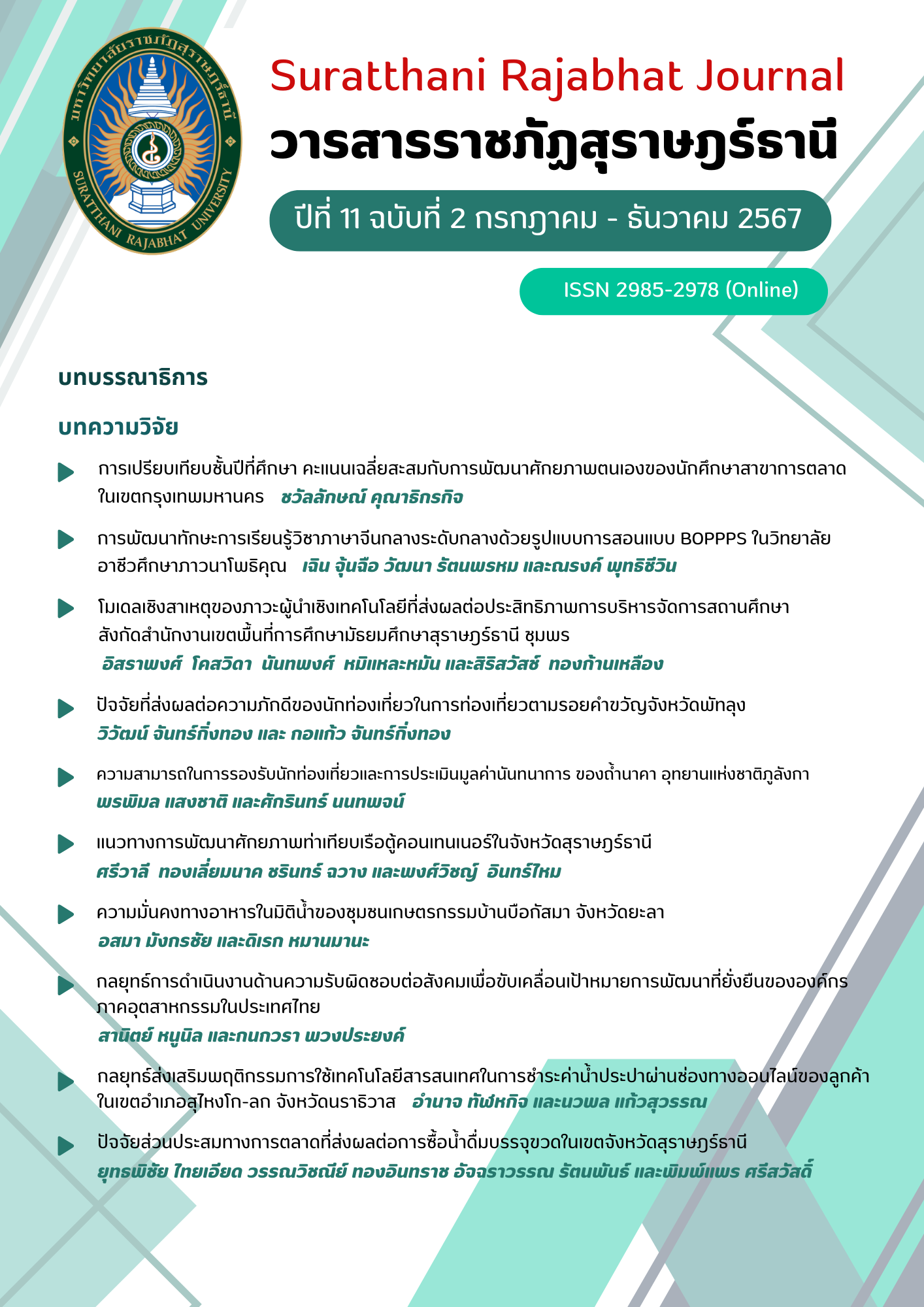The Improvement of Learning Skill with BOPPPS Teaching Model in the Intermediate Chinese Language Course at Bhavana Bodhigun Vocational College
Main Article Content
Abstract
This research objective is to find approaches for improving teaching intermediate Chinese at Bhavana Bodhigun Vocational College. Formerly, Chinese language instruction in Thailand used the PPP teaching model, which was a tradition method and not successful enough. This research developed a new approach to teaching Chinese by applying the BOPPPS model. The aim was to find ways to improve the effectiveness of Chinese language instruction by comparing the BOPPPS model with traditional Chinese teaching methods using the PPP model. The population used in this research consisted of third-year students who chose to take Chinese as an elective course, with a total of 123 students. The sample group consisted of 30 students selected through systematic random sampling, divided into two groups of 15 students each. Group 1 was the experimental group, which received instruction using the BOPPPS model, while the other group, the control group, received traditional PPP instruction. The comparison of the average learning scores of each group using a t-test analysis from the SPSS 24.0 program showed that students who were taught with the BOPPPS model had better learning outcomes than those taught with the PPP model in three skills: listening, speaking, and reading, with statistical significance at the 0.01 level. Meanwhile, students taught with the PPP model had significantly better writing outcomes than those taught with the BOPPPS model at the 0.01 level.
Article Details

This work is licensed under a Creative Commons Attribution-NonCommercial-NoDerivatives 4.0 International License.
References
Bruce, J. & Well, M. (1999). Models of Teaching (6th Edition). Allyn & Bacon Press.
Chickering, A. & Gamson, Z. (1987). Seven Principles for Good Practice in Undergraduate Education. AAHE Bulletin, 39(7), 3-7.
Guan, Y., & Tan, X. (2023). The Developmental Sequence and Functional Relationships of Language Skills: A Case Study of Chinese Reading Experiment with Students from the Oriental Studies College of Bryansk State University in Russia. Journal of Tonghua Normal University, (01), 15-21. http://doi:10.13877/j.cnki.cn22-1284.2023.01.003.
Guo, X. D. (2020). A comparative study of the PPP and PACE models of teaching Chinese as a second language grammar (Master's thesis, East China Normal University).
Huang, S. (2022). Comparing the effectiveness of the PPP and PACE teaching models in junior high school English grammar instruction (Master's thesis). (pp-12), Chongqing, Southwest University.
Jiang, L. P. (2014). HSK Standard Course 3. Beijing Language and Culture University Press.
Liu, T. (2019). The Practice of the BOPPPS Teaching Model in Elementary Chinese Integrated Courses: A Case Study of Confucius Institute at Hasanuddin University SUN. Teaching Site (Master's thesis). Guangzhou: Guangdong University of Foreign Studies.
Liu, X. (2012). Introduction to Teaching Chinese as a Foreign Language. Beijing: Beijing Language and Culture University Press.
Ma, J. (2004). Preliminary Study on the Standardization of Chinese Language Teaching. Language Teaching and Research, P-18.
Ministry of Chinese Education, Center for Language Education and Cooperation. (2021). Chinese Language Proficiency Scales for International Chinese Education [M]. Beijing: Beijing Language and Culture University Press.
O'Hagan, C. (2020). 1.3 billion learners are still affected by school or university closures, as educational institutions start reopening around the world, says UNESCO. https://en.unesco.org/covid19/educationresponse
Pattison, P. & Russell, D. (2006). Instructional Skills Workshop Handbook. Vancouver: UBC Centre for Teaching and Academic Growth.
Piaget, J. (1973) . Psychology and Epistemology: Towards a Theory of Knowledge. Record: Rio de Janeiro.
Pan, F. Q. & Bai, X. W. (2020). A Brief Discussion on the Dynamic Adjustment Mechanism of Enrollment Strategies for International Students Coming to China. China Multimedia and Network Teaching Journal, (08), 70-72.
Pan, Q. (2020). China's Education Opening to the Outside World during the 14th Five-Year Plan Period: Quality Enhancement, Efficiency Improvement, and Path Innovation. Research on Educational Development, 40(23), 43-49.
Skehan, P. (1998) . A Cognitive Approach to Language Learning. Oxford: Oxford University Press.
Thornhill-Miller, B., Camarda, A., Mercier, M., Burkhardt, J. M., Morisseau, T., Bourgeois-Bougrine, S. & Lubart, T. (2023). Creativity, Critical Thinking, Communication, and Collaboration: Assessment, Certification, and Promotion of 21st Century Skills for the Future of Work and Education. Journal of Intelligence, 11(3), 54. https://pubmed.ncbi.nlm.nih.gov/36976147/
Wu, X. H. (2021). How teachers can improve the teaching efficiency of elementary school mathematics classes. New Curriculum, (15), 180.
Wang, Y. & Liu, H. (2021) Prime Minister of Thailand: Expect Huawei to Boost Thailand 4.0 Strategy and Digital Talent Cultivation. International People's Daily. http://world.people.com.cn/n1/2021/1125/c1002-32292158.html
Yang, N. (2021). Application Research of the BOPPPS Model in Intermediate Chinese Listening and Speaking Classes (Master's thesis). Yunnan Normal University.
Yang, X. & Yao, C. (2019). Mathematics Classroom Teaching Based on the BOPPPS Teaching Model. Education and Teaching Forum, 2019(07), 201-202.
Ye, X. (2021). Online Teaching Design of Elementary Integrated Chinese Course for Foreigners Based on the BOPPPS Teaching Model (Unpublished master's thesis). Harbin, China: Harbin Normal University.
Zhang, C. (2021). Application Research on the Online and Offline Teaching Mode of Data Structures Based on the BOPPPS Model. Modern Vocational Education, 28(21), 36-38.
Zhong, C. & Zhang, X. (2020). Application Research of the BOPPPS Model in Teaching Chinese Newspaper Reading for Foreigners: A Case Study of Confucius Institute at University of the Philippines. Hanzi Culture.


